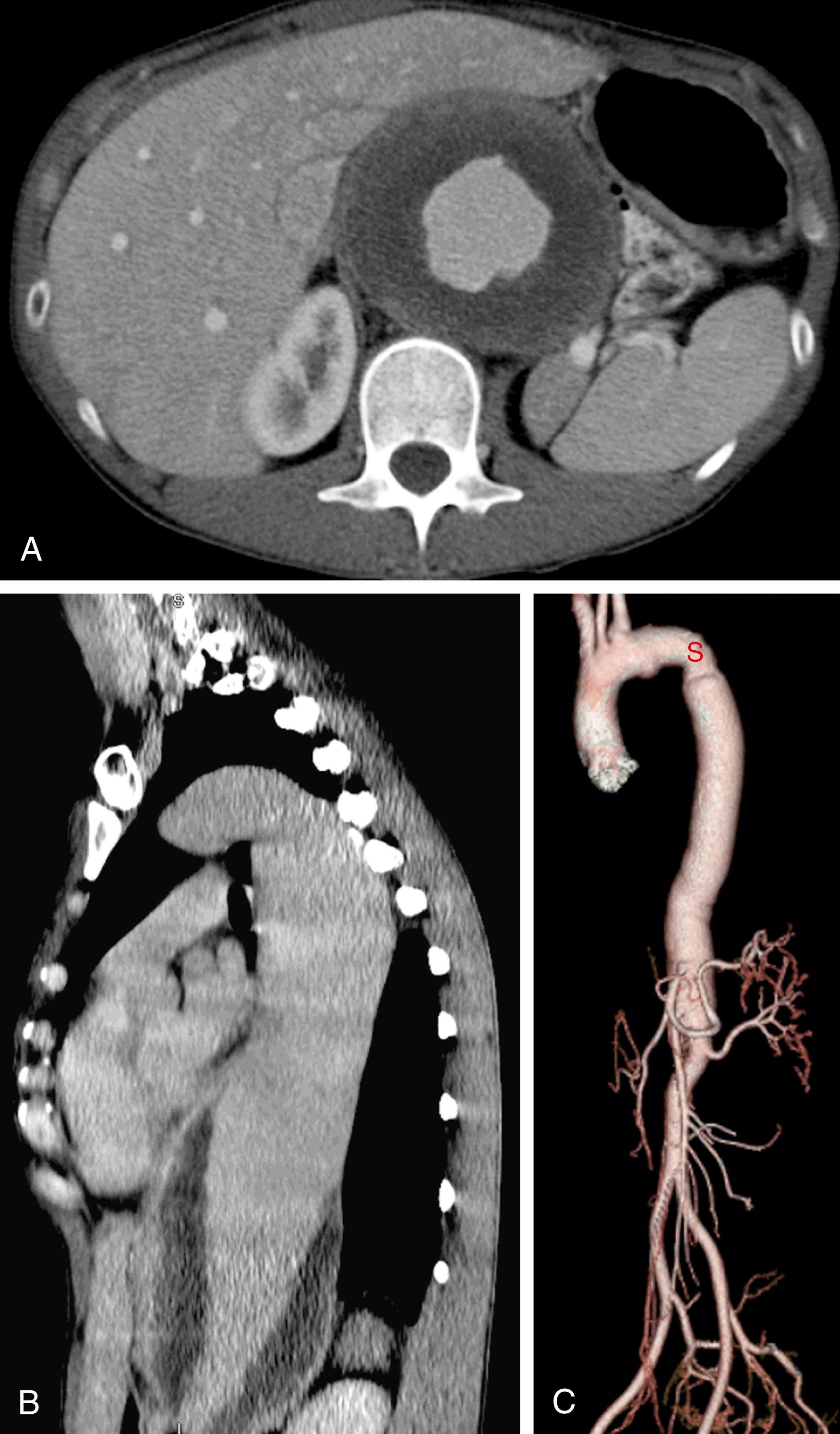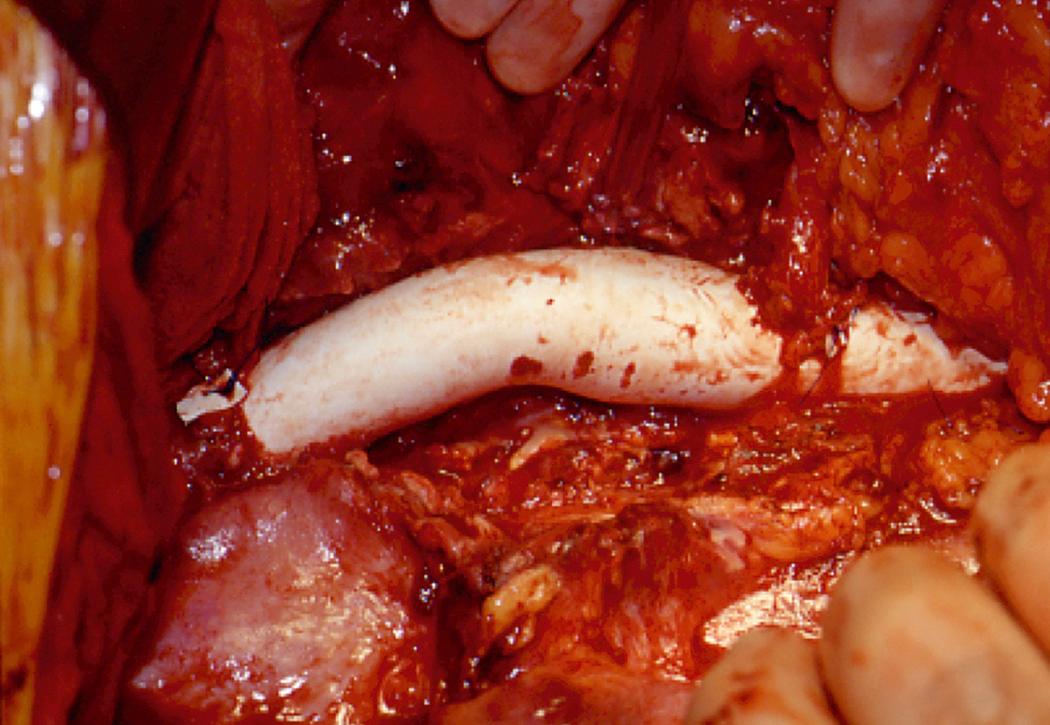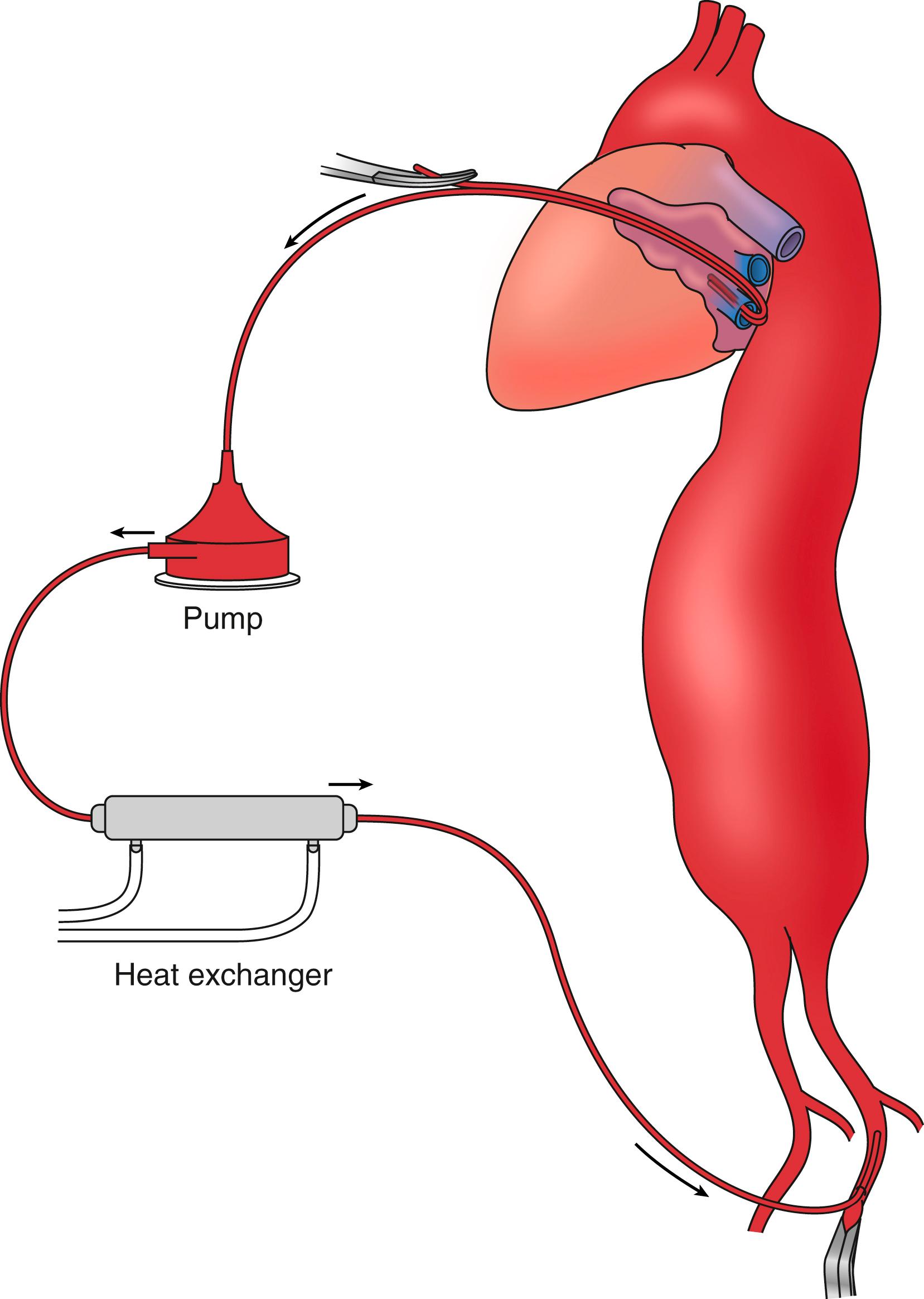Physical Address
304 North Cardinal St.
Dorchester Center, MA 02124
The surgical repair of descending thoracic (DTAA) and especially thoracoabdominal aortic aneurysms (TAAA) remains one of the major challenges in vascular surgery because of the technical demands of the surgery, which may require reattaching brachiocephalic, visceral, renal and intercostal arteries to a synthetic graft or aortic homograft, as well as the physiologic stress of the surgery and the risks of stroke, renal failure, and cardiac or pulmonary complications, and paraplegia leading to significant disability, decline in quality of life, and death. The first successes in treating thoracic aortic disease were by Crafoord, Gross and Etheridge. The difficulty of thoracic aortic surgery was documented early in aortic surgical history by Adams’ 1954 landmark paper on paraplegia causation and risk in thoracic aortic surgery, where he described the anatomy of spinal cord blood flow and the high mortality and paralysis risk of 25% in attempts at just thoracic aortic repair. Ten years later, DeBakey reported 50% mortality in his first small series of TAAA repair. ,
The modern era of surgical treatment of TAAA began with E. Stanley Crawford, who in his first published series in 1974, reported significant reductions in mortality and paraplegia rates accomplished without assisted circulation (AC-cardiopulmonary bypass or left heart bypass). With his lifetime experience of over 1500 TAAA, achieving an overall mortality of 8% and paralysis risk of 16%, Crawford set the standard for a generation of surgeons.
In spite of improved outcomes reported from major centers in the modern era with mortality and paraplegia rates <7% in elective operations, high mortality and morbidity continue to occur as demonstrated in two administrative database studies that documented 20% or higher elective mortality and equally high paraplegia rates in smaller lower volume centers attempting treatment of these challenging complex aneurysms. , In this chapter, we explore how the different pathologies encountered affect surgical approach and treatment indications, the mechanics of repair, and how experienced centers have been able to reduce morbidity and mortality of open surgical repair. To understand paraplegia and mortality risk more comprehensively, we explore how observed/expected (O/E) ratios will be used for paraplegia calculated from a predictive model that was previously published using clinical factors (extent of aortic replacement and clinical acuity and dissection) to compensate for differing populations in clinical reports. Data from our own experience from treating over 1000 patients and a database of over 15,000 patients from published reports will also be described.
Thoracic and thoracoabdominal aortic aneurysm causation and pathologic classification are discussed in Chapter 78 (Thoracic and Thoracoabdominal Aortic Aneurysms: Etiology, Epidemiology, Natural History, Medical Management, and Decision Making). It is important, however, for the surgeon to understand the pathology involved in an individual patient because it can affect technical considerations in thoracoabdominal aneurysm repair.
Degenerative aneurysms are the most common TAAA, usually occurring in older patients who have atherosclerosis and a smoking history. The pathogenesis is complex and associated with the inflammation of atherosclerosis and the individual’s response to injury through matrix metalloproteinases and collagen remodeling of the aorta. Degenerative aneurysms are more likely calcified to varying degrees and may have a damaged and poorly functioning intimal surface covered with debris from plaque and old thrombus, as well as plaque stenosis or occlusion of branch vessels, which makes repair and revascularization more difficult. These older atherosclerotic patients may also have significant cardiac, pulmonary and renal comorbidities, as well as the infirmities of advanced age, significantly increasing treatment risk. Although not common, the inflammatory response in degenerative aneurysms can be so severe that they fall into a category called “inflammatory aneurysms” in which the periaortic structures, like branch vessels, ureters, bowels or mediastinal structures are encased in a dense retroperitoneal fibrosis that makes surgery especially difficult. ,
The known heritable pathologies, like Marfan, Ehlers–Danlos and Loeys–Dietz syndromes, are defined by known genetic mutations that create abnormalities in elastin and collagen and TGF-beta receptors that weaken the aortic wall leading to aortic aneurysms and dissections that usually occur in younger patients. It is also increasingly apparent that similar mutations account for familial aneurysms and other noncategorized patients predisposed to aneurysms and aortic dissection ( Fig. 79.1 ). The quality of the aortic tissue the surgeon is required to work with may vary within a group depending on the severity of the structural defect and differences between pathologic groups with Ehlers–Danlos and Loeys–Dietz patients having more fragile aortas than Marfan patients. , These differences may require different surgical techniques with less traumatic vascular clamps, using hypothermic circulatory arrest to avoid clamping, or the use of aortic wall reinforcement with felt pledgets or strips to secure the suture line because of tissue fragility. In some patients, for example some severe types of Ehlers–Danlos syndrome, surgical repair may not be a viable option , (see Ch. 141 , Aneurysms Caused by Connective Tissue Abnormalities).

Clinical presentation also poses significant challenges for the surgeon as in trauma with multiple injuries or mycotic aortitis where treatment requires radical aortic and periaortic debridement with in situ repair ( Fig. 79.2 ) or aortic oversewing with extra-anatomic bypass in desperate situations.

Thoracoabdominal aneurysm associated with the vasculitis of rheumatoid diseases (ankylosing spondylitis), or the vasculitis of Takayasu disease, lupus erythematosus, or giant cell arteritis, although uncommon, may have associated branch vessel occlusive disease and cardiac and pulmonary involvement, which can complicate repair.
Aneurysms of the thoracoabdominal aorta are classified anatomically (see Ch. 78 , Thoracic and Thoracoabdominal Aortic Aneurysms: Etiology, Epidemiology, Natural History, Medical Management, and Decision Making) primarily by extent of aortic involvement, which is associated with the surgical complexity of repair. Crawford type 2 have the greatest paralysis risk followed by Crawford types 1, 3, 4, and thoracic aortic aneurysms that are confined to the distal arch and descending thoracic aorta, and have the lowest paralysis risk from surgery.
Aortic dissections have a different classification based on origin and extent of the dissection and the need for immediate surgery (Stanford A) and those historically treated medically with antihypertensives, which originate in the distal arch or more commonly in the descending thoracic aorta at or near the ligamentum arteriosum and left subclavian artery (Stanford B) (see Ch. 83 , Aortic Dissection: Epidemiology, Pathophysiology, Clinical Presentation, and Medical and Surgical Management). These classifications capture most but not all of the variation seen clinically and in general indicate increased risk of stroke and paralysis associated with repair.
The primary indication for treatment of aortic aneurysms is rupture risk, which is generally considered to correlate with aortic diameter in accordance with Laplace’s law. The larger the aneurysm and the thinner the wall the more likely it is to rupture, which usually results in death. Some TAAA become very large (>10 cm) before rupture and invariably have thick walls that allow such unusual size before structural failure occurs. However there is considerable variation in TAAA diameter at the time of rupture or other acute event (dissection, plaque hemorrhage), which in our experience averages 8.2 ± 2.8 cm (median 7.4 cm) with only 13% of all ruptures occurring below 6 cm and rarely below 5.5 cm.
Griepp, Elefteriades and others have performed extensive research on the natural history of thoracic aneurysms. These natural history studies indicate that beside diameter and pain, age, the presence of chronic obstructive pulmonary disease (COPD) or renal insufficiency, the extent of the aneurysm, and the expansion rate of the aneurysm are independent risk factors for rupture. The growth rate for DTAA (0.42 cm/year) found by Hirose was the same as the growth rate for AAA found in the ADAM trial. ,
The dilemma in TAAA repair, because of the significantly greater surgical risk than infrarenal AAA repair, is if and then when to treat. Most aortic surgeons put the threshold for risk/benefit at about 6 cm from natural history information weighed against surgical risk and long-term survival. , , , It is known from these observational studies that 40%–50% of patients die of other causes before rupture, making the decision for aneurysm treatment much more complex than just natural history, physics and molecular biology. Further, individual patients have differing treatment and rupture risks related to pathology, age, comorbidities and personal preference.
Other indications, such as occlusive or aneurysmal disease of branch vessels (mesenteric or renal ischemia, brachiocephalic, visceral or iliac aneurysms), may lead to treatment of smaller TAAAs. Similarly, acute events of aortic plaque rupture, mycotic aortitis, trauma, renal failure from obstructive uropathy in inflammatory aneurysms, or malperfusion in acute dissection may require aortic repair or bypass with little aneurysmal dilatation. Some patients have significant aneurysm enlargement in the ascending aorta and arch in addition to the thoracoabdominal aorta that requires staged repair, which presents unique technical challenges. In addition to all these factors, new dilemmas are created because of new and advancing endovascular technologies which may require surgical rescue because of failure or surgery to treat aneurysm progression above or below previously placed endografts. The surgeon may also decide to stage or combine open and endograft repair for ascending arch and descending aneurysm repair (see Ch. 80 , Thoracic Aortic Aneurysms: Endovascular Treatment; Ch. 81 , Aortic Stent Graft and Endovascular Treatment of Thoracoabdominal and Aortic Arch Aneurysms: Strategies for Operative Repair; and Ch. 82 , Fenestrated Branched Endograft Treatment of Juxtarenal, Paravisceral, Thoracoabdominal, and Aortic Arch Aneurysms: Device Selection and Technical Considerations).
The decision to treat begins with, and is clarified by, evaluation of cardiac, pulmonary, renal and overall vitality factors to establish patient fitness for elective surgery (see Ch. 34 , Preoperative Evaluation and Management). This evaluation is expensive and time-consuming for patients and families, but is important when discussing operative risk.
Aortic and branch vessel imaging primarily with magnetic resonance imaging (MRI) and computed axial tomographic angiography (CTA) is important for identifying the extent of pathology for preoperative planning (see Ch. 29 , Computed Tomography and Ch. 30 , Magnetic Resonance Imaging and Arteriography). The improved resolution and quality of imaging that has occurred over the last 15 years allows identification of patent intercostal arteries of interest, detailed understanding of complex dissection anatomy, and plaque morphology. A newer and exciting imaging technique is four-dimensional magnetic resonance angiography. With this MRI technique, detailed anatomy and flow dynamics like velocities, flow rates, wall stress and pressure gradients can be measured noninvasively, which increases our clinical understanding of the effects of treatment, as well as the complex flow and stress dynamics in aneurysms and aortic dissection.
Informed consent for complex high risk surgeries for life-threatening diseases is a difficult and nuanced process that should give the patient a realistic understanding of what you face as the surgeon and what they face as the patient, which must include the worst case scenario along with the best if the patient is to make a decision consistent with his goals in treatment. Especially because of the risks of paraplegia, stroke and renal failure in addition to possible ventilator dependence in marginal patients facing DTA or TAAA surgery, the consent conversation has to be a realistic discussion of probability and uncertainty surrounding surgery and what life will be like if the surgical effort fails to return the patient to his preoperative functional status. The older the patient, the more selective both surgeon and patient should be about treatment.
Once the decision for surgery has been made, the surgeon and anesthesiologist have to develop and execute the plan for repair. That plan will depend on anatomy and pathology that can vary greatly between patients, requiring the surgeon and anesthesiologist to adapt. In addition to patient variation, surgeons may favor different surgical approaches ranging from simple cross-clamp (Crawford technique) with adjunctive measures to protect the kidneys and spinal cord, assisted circulation-AC (atrial–femoral or femoral–femoral bypass), or hypothermic circulatory arrest (HCA).
AC is usually atrial–femoral (partial heart bypass) with oxygenated blood coming from a left atrial or left pulmonary vein cannula to a centrifugal pump, which feeds a femoral artery cannula that can retrograde perfuse the pelvic and visceral arteries during proximal repair ( Fig. 79.3 ). The bypass flow rate is adjustable so proximal and distal arterial perfusion pressures can be maintained and is an effective technique to offload the heart, reducing cardiac strain with very proximal aortic clamping. This technique is dependent on the heart and lungs for oxygenation and cerebral circulation but does not require full systemic heparinization. HCA requires complete cardiopulmonary bypass with arterial perfusion cannulas in the femoral artery or ascending aorta and venous return through a femoral vein cannula that usually extends to the right atrial level and superior vena cava and is placed with guide wire and transesophageal echocardiography to confirm location. A left ventricular sump drain is required to prevent cardiac dilatation and pulmonary congestion during cardiopulmonary bypass. Patients are cooled to 16–18 ° C and then circulation is arrested during the proximal anastomosis after which cerebral perfusion is resumed through a side arm on the aortic graft while the remaining aorta is reconstructed. HCA is a complex procedure because of longer pump runs and coagulopathy with bleeding made worse by the large surface area of a thoracoabdominal incision. Profound hypothermia provides excellent organ protection during aortic reconstruction, however because of its complexity this technique is used the least.

Become a Clinical Tree membership for Full access and enjoy Unlimited articles
If you are a member. Log in here